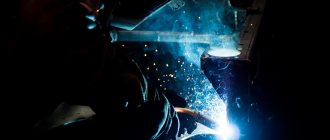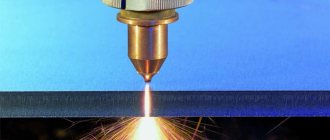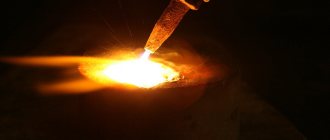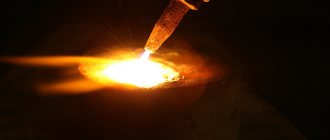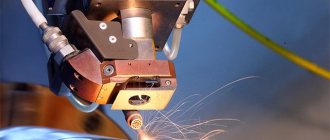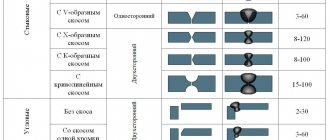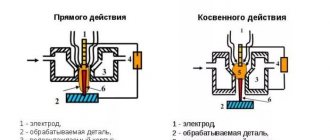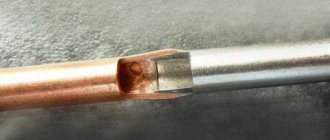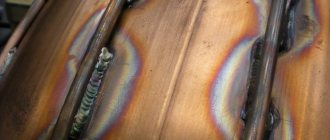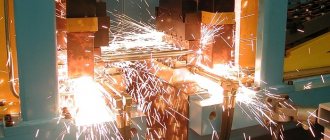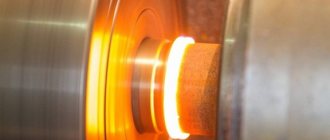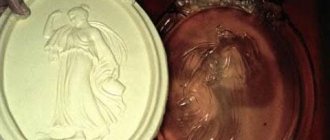Mechanization makes the welder’s work easier, especially when work is carried out on large structures with extended welds. The main advantage of mechanization: the human factor is minimized, the repeatability of the shape and quality of welds is increased, the productivity and economic benefits of welding work are increased.
1 / 1
Regulatory acts used when carrying out welding work
The list of main State standards dedicated to mechanized welding includes:
- GOST 2601-84 Welding of metals . Terms and definitions of basic concepts;
- GOST 14771-76 Gas-shielded arc welding . Welded connections. Main types, structural elements and dimensions;
- GOST 19521-74 Welding of metals . Classification;
- GOST 3.1705-81 Unified system of technological documentation . Rules for recording operations and transitions. Welding;
- GOST 11969-79 Fusion welding . Basic provisions and their designations;
- GOST 29273-92 Weldability . Definition;
- GOST 30430-96 Arc welding of structural cast iron . Requirements for the technological process;
- GOST 2.312-72 Unified system of design documentation . Conventional images and designations of seams of welded joints;
- GOST R ISO 17659-2009 Welding . Multilingual terms for welded joints;
- GOST R ISO 857-1-2009 Welding and related processes . Dictionary. Part 1. Metal welding processes. Terms and Definitions;
- GOST 8713-79 Submerged arc welding . Welded connections. Main types, structural elements and dimensions.
Area of use
This type of technological work is widely used in production:
- ship hulls , components and workpieces in shipbuilding;
- tanks for storing oil and petroleum products;
- steel pipes and main pipelines;
- metal and reinforced concrete structures in construction;
- individual vehicle parts in the automotive industry;
- bridges;
- household metal products (gates, fences);
- when repairing agricultural and automotive equipment , etc.
Mechanized processing technology
First, the surfaces to be treated are prepared. They carry out straightening to eliminate deformations of the rolled product, apply markings, and perform metal cutting and edge processing. The edges are machined using abrasive materials (tools) of high hardness.
Next, select the welding mode. Determine the strength, type and polarity of the current, arc voltage, welding speed, ambient temperature, number of passes, spatial position of the seam.
Electricity is supplied to the electrode, and the workpiece is grounded to initiate and maintain the arc. When these objects come into contact, a welding current is generated. Under the influence of heat, the metal of the electrode and the edge of the product melt. Molten particles of one and the other substance enter the weld pool, where they are mixed into a single mass. In this case, molten slag is formed, which rises to the surface and forms a protective film. Solidification of the metal promotes the formation of a weld.
The quality of the joint is affected by the presence of air. To ensure that the seam remains strong, the location is treated with a protective gas formed during the combustion of carbon, or with flux.
Minuses
- • In some cases, as a result of mixing the base material with the added material, a deterioration in practical properties is observed;
- • if the mode is chosen incorrectly, the deformation caused by high temperatures can be excessive, which requires taking additional measures to preserve the geometry of the workpiece;
- • the master solving the problem needs to have theoretical knowledge in the field of metal compatibility in order to make the coating not just uniform, but with the desired properties;
- • a small number of combinations compared to the same spraying;
- • it is difficult to cover small elements of complex shapes - the bath has to be constantly moved and it is not always possible to do this smoothly.
Partially mechanized welding technology
Partially mechanized welding involves manually moving the torch and/or workpiece and loading and unloading parts. But the supply of filler metal occurs mechanically. Manual adjustment of welding parameters is possible.
There are left and right gas welding methods . The left method involves moving the burner from right to left, while also moving the filler rod in front of the flame. Ideally, the movement should be zigzag, perpendicular to the seam.
Right-hand welding involves straight-line movement of the torch from left to right. The flame is located in front of the rod and directed towards the molten bath. The metal seam does not cool down as quickly as in the first case. Because of this, the strength of the connection and productivity increase, and gas consumption decreases.
Cored wire
We are talking about the so-called “flux-cored” wire for mechanized welding, produced in accordance with the requirements of GOST 26101-84 and having a complex structure. It contains a special shell, partially filled with a charge, due to which individual wire samples reach 40 mm in diameter.
After melting this type of active additive, components are added to the charge to ensure the following tasks:
- protection of the processed metal from the oxygen contained in nitrogen;
- maintaining an even and stable arc;
- obtaining a high-quality seam.
It should also be noted that during mechanized welding, such wire can be used in conjunction with flux and carbon dioxide.
welding equipment
The production of welds is carried out using automatic and semi-automatic devices.
The automatic device includes:
- gas reducer;
- acid cylinder;
- heater;
- dehumidifier.
The main element of the machine is the welding head. The speed of melting depends on the speed at which it feeds the electrode wire (constant or variable).
Approximate cost of automatic devices on Yandex.market
The semi-automatic machine provides wire feeding mechanically. The movement of the arc in the direction of the seam is carried out manually.
Semi-automatic equipment includes:
- electric holder;
- cassette;
- control cabinet;
- welding torch;
- power supply;
- the wire.
Approximate cost of machines for semi-automatic welding on Yandex.market
The main element of the mechanism is the electric holder. It keeps the electrode in a certain position and provides current to the welding area. The arc is activated by a short circuit or a trigger button located on the handle of the holder.
Rice. 1. Scheme of automatic surfacing under a layer of flux: 1 - part; 2 - layer of flux; 3 - gas space; 4 - hopper with flux; 5 - mouthpiece; 6 - electrode; 7 - electric arc; 8 - slag crust; 9 - deposited layer (seam).
When surfacing under a layer of flux, both factors in this formula are significantly larger than during manual welding, so productivity increases by 6... 10 times.
The disadvantages of submerged arc welding are the invisibility of the arc and the significant consumption and cost of flux. The invisibility of the welding site requires increased precision in preparing the product for the process and assembly, and in addition, it complicates welding with a complex seam configuration.
Automatic submerged cladding is used to restore flat and cylindrical parts. Worn tractor and automobile parts are fused on special lathes, which are equipped with a gearbox that allows spindle rotation speed to be obtained in the range from 0.2 to 5 min“1.
The welding head is installed on the machine support. To supply current to the part, a current collector is installed on the spindle. The part prepared for surfacing is clamped in a lathe chuck or in centers. Surfacing of parts with a diameter of less than 80 mm is difficult, and with a diameter of less than 40 mm it is completely impossible. This should be attributed to the disadvantages of this method. To obtain a good quality seam on the surface of the part, the electrode is shifted from the zenith in the direction against the rotation of the part by size a. The displacement depends on the diameter of the part, the strength of the welding current, the length and voltage of the arc, and the rotation speed. When surfacing parts with a diameter of 80...300 mm, the displacement of the electrode ranges from 5 to 30 mm, with a decrease in diameter the displacement increases. In each specific case, the displacement of the electrode is determined experimentally based on the quality of the seam.
Good surfacing quality largely depends on the flux used. In automatic surfacing, fused and unfused ceramic fluxes, as well as mixed fluxes, are used.
Fused fluxes are relatively complex silicates with properties similar to glass. Their melting point is no more than 1200 °C. Based on grain size (0.1...5 mm), they are standardized into four groups. The composition of fused fluxes does not include ferroalloys, free metals, or carbonaceous substances. These fluxes are generally weak deoxidizers. In repair practice, the most widely used fluxes are DN-348A, OSTS-45 and AN-15, containing 35...43% manganese oxide. Such fluxes make it possible to obtain the greatest arc stability, emit less harmful impurities and, in combination with carbon and low-alloy wires, contribute to high quality surfacing.
Ceramic fluxes in their composition and method of preparation are in many ways similar to high-quality (thick) electrode coatings. These fluxes, along with protective ones, contain alloying and modifying elements. Unlike fused fluxes, ceramic fluxes allow you to alloy the deposited layer in a wide range and, when using even cheap low-carbon wire, obtain high-quality wear-resistant coatings. The grain size of the produced ceramic fluxes is 1..3 mm. The most widely used fluxes for surfacing parts are ANK-3, ANK-30, ANK-18, ANK-19 and ZhSN-1.
Flux mixtures are prepared primarily from fused and ceramic in various proportions depending on what properties are important to obtain in the deposited metal. When mixing, it is necessary that the grain size and density are close. Sometimes up to 40% of cast iron shavings are added to fused fluxes, which increases the deposition rate and the hardness of the deposited layer due to its carburization.
The electrode wire for surfacing worn parts under a layer of flux is selected in principle in the same way as for manual surfacing. In addition to welding wire type Sv, special surfacing wire type Np is widely used (Np-30, Np-50G, Np-30Kh5, Np-45Kh4VZF, etc.).
Flux-cored wires are becoming increasingly common in the restoration of parts. They are a continuous electrode with a diameter of 2.5...5.0 mm, consisting of a metal shell filled with powder. A mixture of metal powders, ferroalloys, slag- and gas-forming and other elements similar to those used for electrode coatings is used as a filler. Changing the composition of the filling powders makes it possible to obtain the required quality of the deposited layer with sufficiently high accuracy without additional protection of the surfacing zone with flux or another method.
Flux-cored wires of the PP-AN1, PP-1DSK and other brands when welding or surfacing low- and medium-carbon steels allow one to obtain good quality welds without additional protection. Self-shielding wires of the PP-ZKh13-0, PP-ZKh4VZF-0 and other brands provide a surface of increased wear resistance with a hardness of up to HRC 56 without heat treatment.
Increased productivity when restoring heavily worn parts (track rollers, support rollers, idler wheels of caterpillar tractors, etc.) is achieved by using two and multi-electrode surfacing, as well as surfacing with a steel or powder strip electrode.
Automatic surfacing under a layer of flux is used to restore crankshaft journals and other critical parts whose surfaces are subject to increased wear.
Automatic surfacing in a protective gas environment. In many cases, when it is difficult, impossible or too expensive to use submerged arc welding, other protective media are used: argon, carbon dioxide, steam, etc. Carbon dioxide is most widely used in machine repair.
The essence of the surfacing process in a carbon dioxide environment is as follows. Gas is supplied to the welding zone from special torches mounted on automatic welding heads, as well as using special devices designed for welding in a carbon dioxide environment. From the cylinder, carbon dioxide flows through a tube into the burner nozzle attached to the mouthpiece. By washing the tip and electrode wire, carbon dioxide displaces air and protects the welding area from exposure to nitrogen and oxygen.
The advantages of this method: visibility of the welding site, absence of slag crust, low cost of carbon dioxide compared to flux, and the possibility of applying inconvenient and complex seams, including ceiling ones.
The use of thin electrode wire 0.5...1.2 mm thick at low currents, combined with the visibility of the process, made it possible to widely use this method in the repair of bodies, cabins and tails of tractors and cars.
The disadvantage of surfacing in a carbon dioxide environment is the increased susceptibility of the deposited layer to the formation of cracks, as well as to the burnout of alloying elements. This is facilitated by the decomposition of carbon dioxide at high temperatures into carbon monoxide and atomic oxygen. This harmful phenomenon is prevented by using electrode wire with a high content of manganese, silicon, chromium, titanium and other deoxidizing agents.
Sometimes steam is used instead of carbon dioxide to protect the welding area. In this case, a new burner nozzle is made, which differs in that an annular cavity is made in the inner part to collect condensate. Steam is much cheaper than flux and carbon dioxide, but the weld being welded can result in pores and cracks. Therefore, steam is used for surfacing non-critical parts: track rollers, support rollers, idler wheels, etc.
Rice. 2. Scheme of automatic surfacing in a carbon dioxide environment: 1 - mouthpiece; 2 — tube for carbon dioxide; 3 - nozzle; 4 - tip; 5 - electrode wire.
Automatic surfacing equipment consists of a power source, a welding head and a surfacing machine or converted lathe.
Current power supplies. Direct current is usually used because it is more difficult to achieve a stable arc with alternating current. As a current source, welding converters of the PSO-300, PD-501, GD-502 types or universal welding rectifiers of the VDU-305, VDU-504, VDU-1201 and VDU-1601 types are used. In addition, for automatic welding and surfacing, the industry produces special rectifiers of the VDG-601 type.
The welding head is the main element of an automatic surfacing installation. It consists of a feed mechanism with an electric motor and a gearbox, which allows you to change the wire feed speed over a wide range; cassettes for electrode wire; flux hopper and equipment box or control panel. Repair enterprises use heads of the brands A-580M, A-874M, A-874S, A-384MK, OKS-5523 GOSNITI, etc.
Along with automatic welding and surfacing machines, semi-automatic machines are widely used. In them, only the supply of wire and flux is mechanized, and the welding arc is moved manually. Therefore, the conductive mouthpiece is separated from the wire feed mechanism and is designed as a holder for ease of use. The wire feed mechanism is connected to the holder by a flexible hose, inside which the electrode wire passes. This allows for great maneuverability. This semi-automatic machine can weld seams of any configuration, even in hard-to-reach places.
The division of welding machines into automatic and semi-automatic can be considered conditional. It is enough to fix the holder of the semi-automatic machine on the support of the lathe, and impart a constant speed of movement to the welded part in the direction of the welded seam, and the semi-automatic machine turns into an automatic machine. Therefore, semi-automatic machines are used more widely at repair plants than automatic machines. According to their purpose, semi-automatic machines are conventionally divided into semi-automatic machines for submerged arc welding, gas-shielded welding, universal and special.
d For submerged arc welding, semi-automatic machines PSh-54, PDShM-500 and PDShR-500 are used, but in repair practice they have not received much use due to the invisibility of the arc during welding and low maneuverability. In repairs, semi-automatic machines of the brands A-547U, A-547R, PDPG-500, A-929S and others for welding in shielding gases and universal semi-automatic machines of the brands A-715, A-765, A-1197 and others are more widely used. Universal semi-automatic devices are equipped with replaceable standardized equipment that allows them to be used for welding and surfacing under a layer of fluxes, in shielding gases, as well as with solid and flux-cored wires.
Special semi-automatic machines are produced for welding in installation or field conditions and, in addition, for welding non-ferrous metals.
Portable semi-automatic machines A-1114 and backpack type PDG-304 are designed for welding in installation and field conditions on direct current with wire with diameters from 0.8 to 2 mm. The semi-automatic machine PShP-10 is designed for welding aluminum and its alloys in shielding gases.
Surfacing machines. As a device for moving the welded part, an automatic and welding head, repair plants often use a lathe equipped with a special gearbox that reduces the spindle speed. The welded part is mounted in the spindle or in the centers of the machine, and the welding head is mounted on the support. But universal (U-651, U-652, etc.) and specialized (U-425, U-427, etc.) surfacing machines have already been developed.
Vibrating arc surfacing is a type of automatic surfacing under a layer of flux and in protective gases. It differs in that welding is carried out with a wire electrode with a frequency of 50...110 vibrations per second. The amplitude of vibration of the electrode relative to the welded part is usually 1...3 mm. Vibration of the electrode significantly affects the quality of surfacing and the entire course of the process and provides a number of advantages compared to conventional electric arc surfacing.
Due to the rupture of the arc during vibro-arc surfacing, a small-droplet transition of metal from the electrode to the part occurs; the minimum possible weld pool is formed, which promotes fairly good fusion of the electrode metal with the main metal, slight heating of the part and the creation of a small-depth heat-affected zone. In addition, the burnout of the alloying elements of the electrode wire is reduced compared to conventional arc surfacing. Vibro-arc surfacing can produce relatively thin and very durable coatings with a thickness of 0.8...2.5 mm on round parts with a diameter of 15 mm and more.
Often, when vibrating arc surfacing, a coolant (3...5% aqueous solution of soda ash) is used, which is supplied to the part in the form of a jet 15...20 mm above the arc combustion zone.
Along with its advantages, vibrating arc surfacing also has a number of disadvantages. The deposited layer often turns out to be porous and heterogeneous in hardness and metal structure. As a result, the fatigue strength of parts is reduced by almost 2 times. In this regard, the use of vibration-arc surfacing for the restoration of critical parts subjected to large alternating and cyclic loads (trunnions, crankshafts, etc.) is very limited. The productivity of vibro-arc surfacing is lower than conventional automatic surfacing, and losses due to spattering and waste are higher and reach 6...8%.
Vibrating-arc surfacing is carried out predominantly using direct current of reverse polarity at a voltage of 12...20 V and a current density of 50...70 A/mm2.
To obtain wear-resistant layers, high-carbon surfacing wires Np-65, Np-80, Np-65G, spring wire, etc. are used. The quality of surfacing is increased by protecting the welding zone with carbon or other gases.
The same converters and rectifiers are used as power sources as in conventional automatic surfacing.
Welding heads are fundamentally designed in the same way as automatic welding heads, but unlike the latter they do not have a hopper for flux and are equipped with a vibrator. Repair enterprises mainly use surfacing heads with a mechanical vibrator OKS-1252, OKS-6569, VG-4, VG-5 and VG-8M. The latter is intended for vibro-arc surfacing in a carbon dioxide environment.
Mechanized submerged arc welding
Flux is a powdery substance for welding that complies with GOST 8713-79. Its properties resemble electrode coating, and the main substance is manganese silicate.
Flux can be fused or unfused. The former include substances that have undergone high-temperature treatment in ovens. The second category includes fluxes of ceramic origin and powders, sintered and crushed to a certain size.
Most often, submerged arc welding is used to join high-alloy and stainless steel, aluminum and copper alloys.
Approximate cost of flux on Yandex.market
Disadvantages of seams
Defects in welding seams occur due to:
- differential heating of a metal product;
- shrinkage of the molten substance;
- structural changes in a chemical element.
To prevent welding imperfections, parts are secured in special tools. This option is ideal for viscous compounds that do not cause cracking.
Some welders use the reverse strain method or the method of complete (partial) elimination of internal stresses.
The classic case of eliminating deficiencies is heat treatment through high tempering. The product is heated to 650°C and after a short exposure is slowly cooled.
pros
- • it is possible to create coatings of considerable thickness (up to 2-3 mm) and thus return the original geometry even to heavily worn products;
- • productivity is 1.5-3 times higher than with any of the manual methods;
- • the equipment used is relatively reliable and easy to transport;
- • there are no restrictions on the size of objects - blast furnace cones, nuclear reactor vessels and other large objects can also be effectively protected and restored;
- • each method is quite easy to implement;
- • the applied layer can be of any composition, from pure copper to combined plastic;
- • it is not a problem to combine surfacing with other processing methods, for example, with nitriding or plasma hardening.
